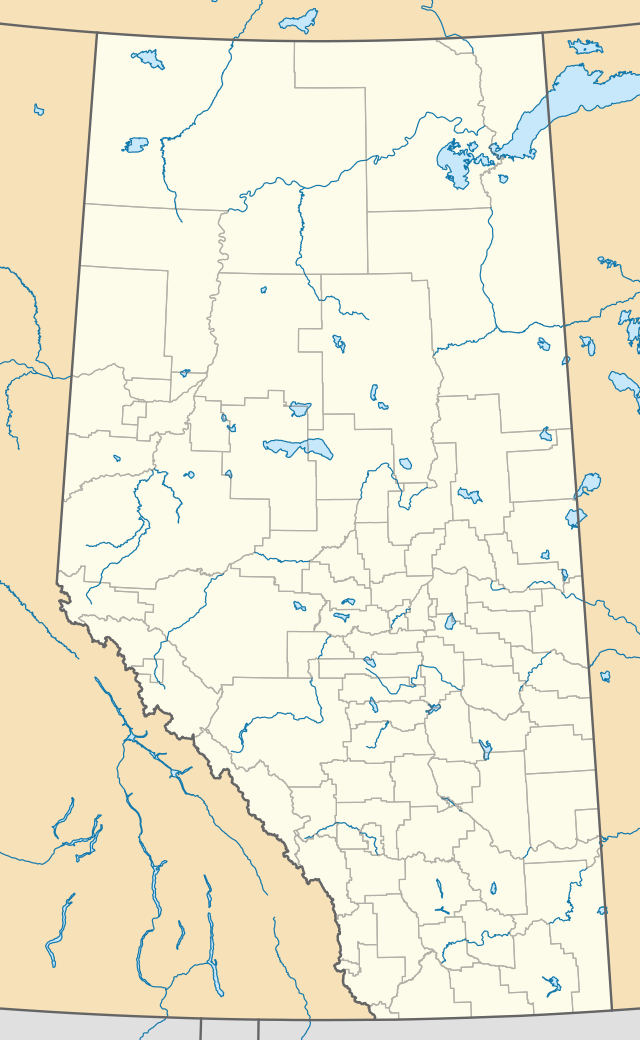Wanham, Alberta
Wanham is a hamlet in northern Alberta, Canada within Birch Hills County.[1] It is located 29 km (18 mi) east of Rycroft along Highway 49 and approximately 106 km (66 mi) north of Grande Prairie, in the farmlands of Peace River Country. Saddle River, a tributary of Peace River, flows immediately north of the settlement.

The local economy is based on agriculture and ranching, the settlement being an agricultural service centre for the surrounding farms. A wood products plant, Newpro, was previously the largest employer in the settlement. It was announced it was closing in January 2006.
History
It was established in 1916 as a station on the railway.[2] The first post office was built in 1918.
It was incorporated as a village, but dissolved and merged with Birch Hills County in 1999 by Order in Council 458/99.[3] Birch Hills County's municipal office is located in Wanham.
Demographics
| Year | Pop. | ±% |
|---|---|---|
| 1961 | 251 | — |
| 1966 | 235 | −6.4% |
| 1971 | 268 | +14.0% |
| 1976 | 225 | −16.0% |
| 1981 | 266 | +18.2% |
| 1986 | 233 | −12.4% |
| 1991 | 216 | −7.3% |
| 2011 | 127 | −41.2% |
| 2016 | 124 | −2.4% |
| Source: Statistics Canada [4][5][6][7][8] | ||
As a designated place in the 2016 Census of Population conducted by Statistics Canada, Wanham recorded a population of 124 living in 62 of its 78 total private dwellings, a change of -2.4% from its 2011 population of 127. With a land area of 0.99 km2 (0.38 sq mi), it had a population density of 125.3/km2 (324.4/sq mi) in 2016.[8]
Attractions
A yearly plowing competition takes place in Wanham since 1971. It is currently named Alberta Provincial and Canadian Plowing Match and includes a horse drawn antique parade, live music and fashion show.
The Grizzly Bear Prairie Museum is seasonally opened in Wanham. It was founded in 1979 by a group called the Community of Cooperating Organization (COCO for short). It was officially opened in 1981.
Climate
| Climate data for Wanham | |||||||||||||
|---|---|---|---|---|---|---|---|---|---|---|---|---|---|
| Month | Jan | Feb | Mar | Apr | May | Jun | Jul | Aug | Sep | Oct | Nov | Dec | Year |
| Record high °C (°F) | 11.7 (53.1) |
14.5 (58.1) |
17.2 (63.0) |
29.4 (84.9) |
32 (90) |
33.9 (93.0) |
33 (91) |
36 (97) |
31.5 (88.7) |
26.7 (80.1) |
18 (64) |
11 (52) |
33.9 (93.0) |
| Average high °C (°F) | −9.3 (15.3) |
−6 (21) |
0.9 (33.6) |
10.3 (50.5) |
17.3 (63.1) |
20.7 (69.3) |
22.4 (72.3) |
21 (70) |
16.1 (61.0) |
9.4 (48.9) |
−2 (28) |
−8 (18) |
7.7 (45.9) |
| Daily mean °C (°F) | −14.8 (5.4) |
−11.7 (10.9) |
−4.8 (23.4) |
4.2 (39.6) |
10.5 (50.9) |
14.5 (58.1) |
16.2 (61.2) |
14.8 (58.6) |
10 (50) |
3.9 (39.0) |
−6.8 (19.8) |
−13.3 (8.1) |
1.9 (35.4) |
| Average low °C (°F) | −20.3 (−4.5) |
−17.3 (0.9) |
−10.5 (13.1) |
−1.9 (28.6) |
3.8 (38.8) |
8.2 (46.8) |
10 (50) |
8.4 (47.1) |
3.8 (38.8) |
−1.5 (29.3) |
−11.5 (11.3) |
−18.7 (−1.7) |
−4 (25) |
| Record low °C (°F) | −48.3 (−54.9) |
−45 (−49) |
−37 (−35) |
−22.8 (−9.0) |
−7.2 (19.0) |
−3.9 (25.0) |
0 (32) |
−4.5 (23.9) |
−10.6 (12.9) |
−28 (−18) |
−41.1 (−42.0) |
−50 (−58) |
−50 (−58) |
| Average precipitation mm (inches) | 29.1 (1.15) |
21.4 (0.84) |
18.6 (0.73) |
22.2 (0.87) |
40.6 (1.60) |
75.8 (2.98) |
72.4 (2.85) |
65.8 (2.59) |
42.2 (1.66) |
28 (1.1) |
24.2 (0.95) |
27.8 (1.09) |
468 (18.4) |
| Source: Environment Canada[9] | |||||||||||||
See also
References
- Alberta Municipal Affairs (1 April 2010). "Specialized and Rural Municipalities and Their Communities" (PDF). Retrieved 20 June 2010.
- Discover the Peace Country. "Wanham". Retrieved 20 June 2007.
- Alberta Municipal Affairs (June 2007). "Birch Hills County". Retrieved 20 June 2007.
- "Table 9: Population by census subdivisions, 1966 by sex, and 1961". 1966 Census of Canada. Western Provinces. Population: Divisions and Subdivisions. Ottawa: Dominion Bureau of Statistics. 1967.
- "Table 3: Population for census divisions and subdivisions, 1971 and 1976". 1976 Census of Canada. Census Divisions and Subdivisions, Western Provinces and the Territories. Population: Geographic Distributions. Ottawa: Statistics Canada. 1977.
- "Table 2: Census Subdivisions in Alphabetical Order, Showing Population Rank, Canada, 1981". 1981 Census of Canada. Census subdivisions in decreasing population order. Ottawa: Statistics Canada. 1982. ISBN 0-660-51563-6.
- "Table 2: Population and Dwelling Counts, for Census Divisions and Census Subdivisions, 1986 and 1991 – 100% Data". 91 Census. Population and Dwelling Counts – Census Divisions and Census Subdivisions. Ottawa: Statistics Canada. 1992. pp. 100–108. ISBN 0-660-57115-3.
- "Population and dwelling counts, for Canada, provinces and territories, and designated places, 2016 and 2011 censuses – 100% data (Alberta)". Statistics Canada. 8 February 2017. Retrieved 13 February 2017.
- Environment Canada—. Retrieved 7 April 2010.